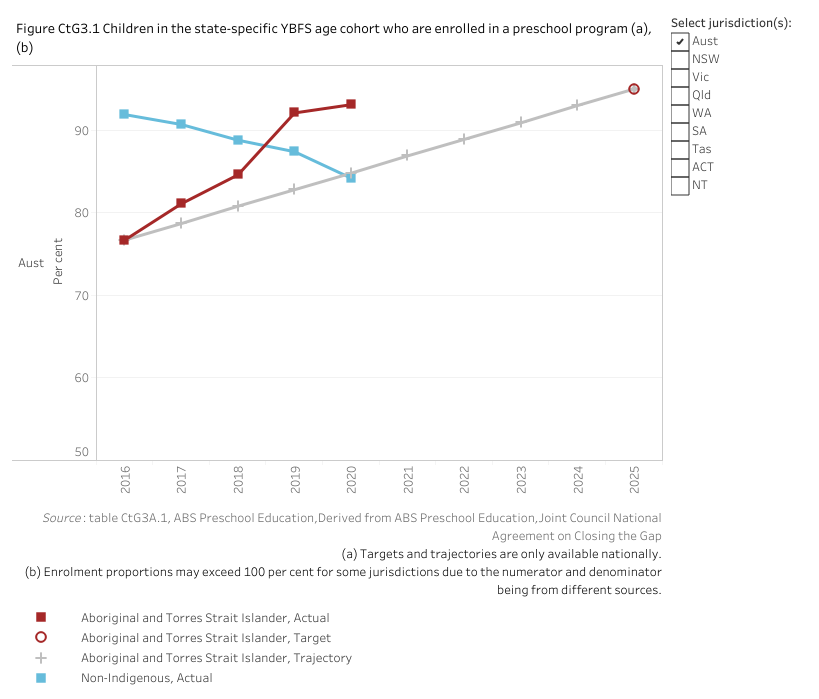TARGET 3
By 2025, increase the proportion of Aboriginal and Torres Strait Islander children enrolled in Year Before Full time Schooling (YBFS) early childhood education to 95 per cent
Dashboard snapshot: The data below are the most recent at the time of preparing the July 2021 report. Please go to the dashboard to access the current data.
Nationally in 2020, 93.1 per cent of Aboriginal and Torres Strait Islander children in the Year Before Full time Schooling (YBFS) age cohort were enrolled in a preschool program (figure CtG3.1).
This is an increase from 76.7 per cent in 2016 (the baseline year).
Nationally, based on the most recent year of data, the target is on track to be met.

The assessment below reflects progress from the baseline year to the current year (ie improvement or otherwise in the rate). This differs to the national assessment against the trajectory (above), which compares the current year rate to the rate on the target trajectory at the same time period.
Target data specifications
Outcome: | Aboriginal and Torres Strait Islander children are engaged in high quality, culturally appropriate early childhood education in their early years. |
|---|---|
Target: | By 2025, increase the proportion of Aboriginal and Torres Strait Islander children enrolled in Year Before Full time Schooling (YBFS) early childhood education to 95 per cent. |
Indicator: | The proportion of Aboriginal and Torres Strait Islander children in the state-specific YBFS age cohort who are enrolled in a preschool program. |
Measure: | This measure is defined as: Numerator — the estimated number of children in the state-specific YBFS age cohort enrolled in a preschool program Denominator — the estimated number of children in the state-specific YBFS potential population and is presented as a percentage. |
Target established: | National Agreement on Closing the Gap July 2020 |
Latest dashboard update: | 23 June 2021 |
Indicator type: | Target |
Interpretation of change: | A high or increasing rate is desirable. An increase from the baseline year is an improvement. |
Data source(s): | Name (numerator): Preschool Education, Australia Frequency: Annual Name (denominator): Estimates and Projections for Aboriginal and Torres Strait Islander population Frequency: Annual (data revised on a five-yearly basis) Documentation (links): https://www.abs.gov.au/statistics/people/education/preschool-education-australia |
Data provider: | Provider name: Australian Bureau of Statistics Provider area: Preschool education |
Baseline year: | 2016. This is an existing National Indigenous Reform Agreement (NIRA) target. While the official baseline for this target is 2015, data are only comparable from 2016 onwards (see Data quality considerations). |
Target year: | 2025 |
Disaggregations: | State and territory and Australia, by Indigenous status. |
Computation: | Numerator divided by Denominator multiplied by 100 Counting rules The state-specific YBFS age cohort is an estimate of a single year cohort for the population that will transition to full time schooling in the following year. The state-specific YBFS definition uses the preschool and school age entry provisions of the state or territory in which the child usually resides. See Preschool Education, Australia methodology (http://www.abs.gov.au/methodologies/preschool-education-australia-methodology/) Numerator:
Denominator:
Excludes (denominator):
|
Data quality considerations: | Data for Preschool Education, Australia are collected through the National Early Childhood Education and Care Collection (NECECC). Data are not fully comparable over time, or across jurisdictions, due to differences and changes in coverage and methodologies. See Preschool Education, Australia methodology (http://www.abs.gov.au/methodologies/preschool-education-australia-methodology/) for a description of the data collection methodologies and quality declarations. Methods for the identification of Indigenous status vary by jurisdiction. For data supplied via the Australian Government's child care subsidy system (CCSS), children of families who choose not to identify as Aboriginal and/or Torres Strait Islander are classified as ‘non-Indigenous’ rather than ‘unknown/not stated’. Nationally in 2020, YBFS preschool enrolments with a ‘not stated’ Indigenous status were 0.2 per cent of all YBFS preschool enrolments. (Tasmania had the largest proportion with 4.1 per cent, followed by SA with 1.0 per cent). The calculation of preschool enrolment rates for this indicator differs to the calculations used for reporting under the National Partnership on Universal Access to Early Childhood Education and the annual Report on Government Services (RoGS). The calculations reported for the National Partnership do not restrict to the year before full time schooling, and the RoGS does not prorate for unknown Indigenous status. Tasmania and the ACT have relatively small Aboriginal and Torres Strait Islander populations compared to the other states and territories which means year-to-year variability in single year of age populations may be more pronounced. This may result in year-to-year variability of the rate of preschool enrolment in these jurisdictions and should be used with caution. |
Future reporting: | Additional disaggregations required for future reporting:
|
Supporting indicators
Contextual information
- Rate of attendance in early childhood education in the year before full-time schooling
- Number of Aboriginal and Torres Strait Islander early childhood education and care service providers
- Progress towards parity
